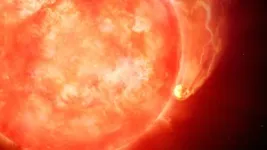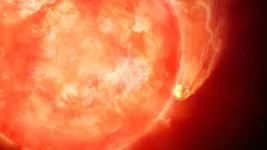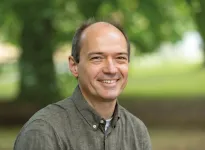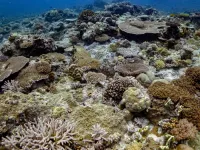(Press-News.org) Menlo Park, Calif. – Photosynthesis plays a crucial role in shaping and sustaining life on Earth, yet many aspects of the process remain a mystery. One such mystery is how Photosystem II, a protein complex in plants, algae and cyanobacteria, harvests energy from sunlight and uses it to split water, producing the oxygen we breathe. Now researchers from the Department of Energy’s Lawrence Berkeley National Laboratory and SLAC National Accelerator Laboratory, together with collaborators from Uppsala University and Humboldt University and other institutions have succeeded in cracking a key secret of Photosystem II.
Using SLAC’s Linac Coherent Light Source (LCLS) and the SPring-8 Angstrom Compact free electron LAser (SACLA) in Japan, they captured for the first time in atomic detail what happens in the final moments leading up to the release of breathable oxygen. The data reveal an intermediate reaction step that had not been observed before.
The results, published today in Nature, shed light on how nature has optimized photosynthesis and are helping scientists develop artificial photosynthetic systems that mimic photosynthesis to harvest natural sunlight to convert carbon dioxide into hydrogen and carbon based-fuels.
“The more we learn about how nature does it, the closer we get to using those same principles in human-made processes, including ideas for artificial photosynthesis as a clean and sustainable energy source,” said co-author Jan Kern, a scientist at Berkeley Lab.
Co-author Junko Yano, also at Berkeley Lab, said, “Photosystem II is giving us the blueprint for how to optimize our clean energy sources and avoid dead ends and dangerous side products that damage the system. What we once thought was just fundamental science could become a promising avenue to improving our energy technologies.”
Bases loaded
During photosynthesis, Photosystem II’s oxygen-evolving center – a cluster of four manganese atoms and one calcium atom connected by oxygen atoms – facilitates a series of challenging chemical reactions that act to split apart a water molecule to release molecular oxygen.
The center cycles through four stable oxidation states, known as S0 through S3, when exposed to sunlight. On a baseball field, S0 would be the start of the game when a player on home base is ready to go to bat. S1-S3 would be players on first, second, and third. Every time a batter connects with a ball, or the complex absorbs a photon of sunlight, the player on the field advances one base. When the fourth ball is hit, the player slides into home, scoring a run or, in the case of Photosystem II, releasing one molecule of breathable oxygen.
In their experiments, the researchers probed this center by exciting samples from cyanobacteria with optical light and then probing them with ultrafast X-ray pulses from LCLS and SACLA. The data revealed the atomic structure of the cluster and the chemical process around it.
A homerun
Using this technique, the scientists for the first time imaged the mad dash for home – the transient state, or S4, where two atoms of oxygen bond together and an oxygen molecule is released. The data showed that there are additional steps in this reaction that had never been seen before.
“Other experts argued that this is something that could never be captured,” said co-author Uwe Bergmann, a scientist and professor at the University of Wisconsin-Madison. “It’s really going to change the way we think about Photosystem II. Although we can't say we have a unique mechanism based on the data yet, we can exclude some models and ideas people have proposed over the last few decades. It’s the closest anyone has ever come to capturing this final step and showing how this process works with actual structural data.”
The new study is the latest in a series undertaken by the team over the past decade. Earlier work focused on observing various steps of the photosynthetic cycle at the temperature at which it occurs in nature.
“Most of the process that produces breathable oxygen happens in this last step,” said co-author Vittal Yachandra, a scientist at Berkeley Lab. “But there are several things happening at different parts of photosystem II and they all have to come together in the end for the reaction to succeed. Just like how in baseball, factors like the location of the ball and the position of the basemen and fielders affect the moves a player takes to get to home base, the protein environment around the catalytic center influences how this reaction plays out.”
Brighter X-rays for a brighter future
Based on these results, the researchers plan to conduct experiments designed to capture many more snapshots of the process.
“There are still things happening in between that we could not catch yet,” Kern said. “There are more snapshots we really want to take which would bridge the remaining gaps and tell the whole story.”
To do so, they need to push the quality of their data even further. In the past, these types of measurements proved challenging because the X-ray signals from the samples are faint and the rates at which existing X-ray lasers like LCLS and SACLA produce X-ray pulses are too small.
“It took quite some effort to optimize the setup, so we couldn't collect all the data we needed for this one publication in a single experiment,” said co-author and SLAC scientist Roberto Alonso-Mori. “These results actually include data taken over six years.”
When an LCLS upgrade, called LCLS-II, comes online later this year, the repetition rate will skyrocket from 120 pulses per second to up to a million per second.
“With these upgrades, we will be able to collect several days’ worth of data in just a few hours,” Bergmann said. “We will also be able to use soft X-rays to further understand the chemical changes happening in the system. These new capabilities will continue to drive this research forward and shed new light on photosynthesis.”
SLAC is a vibrant multiprogram laboratory that explores how the universe works at the biggest, smallest and fastest scales and invents powerful tools used by scientists around the globe. With research spanning particle physics, astrophysics and cosmology, materials, chemistry, bio- and energy sciences and scientific computing, we help solve real-world problems and advance the interests of the nation.
SLAC is operated by Stanford University for the U.S. Department of Energy’s Office of Science. The Office of Science is the single largest supporter of basic research in the physical sciences in the United States and is working to address some of the most pressing challenges of our time.
Additional visual:
Animation
https://drive.google.com/file/d/1v8mlrQ47z5jWonNcsVjXruweVS0v5dE4/view?usp=sharing
The machinery responsible for photosynthesis – while commonplace and essential to life on Earth – is still not fully understood. One of its molecular mysteries involves how a protein complex, Photosystem II, harvests energy from light and uses it to split water into hydrogen and oxygen. This video explains how, in a previous paper, researchers were able to see two key steps in photosynthetic water splitting under conditions as it occurs in nature, a big step to decoding how the process works in detail. (Chris Smith/SLAC National Accelerator Laboratory)
END
Researchers capture elusive missing step in the final act of photosynthesis
After decades of effort, scientists have finally seen the process by which nature creates the oxygen we breathe using SLAC’s X-ray laser.
2023-05-03
ELSE PRESS RELEASES FROM THIS DATE:
Association between depression and physical conditions requiring hospitalization
2023-05-03
About The Study: In this study that included 240,000 individuals, the most common causes of hospitalization in people with depression were endocrine, musculoskeletal, and vascular diseases, not psychiatric disorders. These findings suggest that depression should be considered as a target for the prevention of physical and mental disease.
Authors: Philipp Frank, Ph.D., of University College London, is the corresponding author.
To access the embargoed study: Visit our For The Media website at this link https://media.jamanetwork.com/
(10.1001/jamapsychiatry.2023.0777)
Editor’s ...
Astronomers witness star devouring planet: possible preview of the ultimate fate of Earth
2023-05-03
By studying countless stars at various stages of their evolution, astronomers have been able to piece together an understanding of the life cycle of stars and how they interact with their surrounding planetary systems as they age. This research confirms that when a Sun-like star nears the end of its life, it expands anywhere from 100 to 1000 times its original size, eventually engulfing the system’s inner planets. Such events are estimated to occur only a few times each year across the entire Milky Way. Though past observations have confirmed the aftermath of planetary engulfments [1], ...
Discovery suggests route to safer pain medications
2023-05-03
Strategies to treat pain without triggering dangerous side effects such as euphoria and addiction have proven elusive. For decades, scientists have attempted to develop drugs that selectively activate one type of opioid receptor to treat pain while not activating another type of opioid receptor linked to addiction. Unfortunately, those compounds can cause a different unwanted effect: hallucinations. But a new study led by Washington University School of Medicine in St. Louis has identified a potential route ...
XFELs show the final milliseconds of oxygen formation
2023-05-03
For the first time, scientists have been able to see the crucial final step in the reaction cycle of Photosystem II, during which oxygen is formed. Using serial femtosecond crystallography performed with the XFEL technique, they have managed to obtain more information on the interaction between Photosystem II and the Mn/Ca cluster. This has been shown in a new study by Uppsala University, published in the journal Nature.
The oxygen we breathe is produced by plants, algae and cyanobacteria, which use the energy of sunlight for powering the formation of oxygen. This is done by the Photosystem II enzyme, ...
To boost cancer immunotherapy’s fighting power, look to the gut
2023-05-03
Cancer immunotherapy has transformed the treatment of many types of cancer. Yet, for reasons that remain poorly understood, not all patients get the same benefit from these powerful therapies.
One potent factor in treatment outcome appears to be an individual’s gut microbiota — the trillions of microorganisms that live in the human intestine — according to new research led by investigators at Harvard Medical School and Dana-Farber Cancer Institute.
The study, done in mice and published May 3 in Nature, pinpoints how gut microbes enhance the body’s response to a common type of immunotherapy known as PD-1 checkpoint ...
Minoan eruption survey improves volcanic risk assessments
2023-05-03
Volcanic eruptions are spectacular, violent and dangerous. Large explosive eruptions can even have global impacts. To classify the size of volcanic eruptions, the magma volume and the deposition volume are determined. Volcanologists estimate these values in order to compare the size of different volcanic eruptions or to obtain a measure of the explosiveness of the eruption. However, it is often not possible to determine the values accurately. This makes it difficult to infer the actual volume of magma and to measure the complete extent of such eruptions. In particular, because the deposits of the most violent historical eruptions are partially or completely under water, which makes geological ...
Indo-Pacific corals more resilient to climate change than Atlantic corals
2023-05-03
UNIVERSITY PARK, Pa. — In the face of global warming and other environmental changes, corals in the Atlantic Ocean have declined precipitously in recent years, while corals in the Pacific and Indian Oceans are faring better. By describing several species of symbiotic algae that these corals need to grow, an international team led by Penn State has found that these mutualistic relationships from the Indo-Pacific may be more flexible and ultimately resilient to higher ocean temperatures than those in the Atlantic.
Coral reefs are vast geological structures made of calcium carbonate produced by coral animals whose colonies possess dense populations ...
More woodlands will not impact tourism
2023-05-03
Hiking, cycling, climbing and boating. When we take time off from work or school, we like to go out into nature. The landscape in other words play an important role for our vacations. To promote biodiversity and carbon sequestration there is a focus on planting more trees, especially in upland areas such as Howgill Fells. The Howgill Fells is located in the north-west of England and is known for its soft, rolling and open landscape. It is a popular area for tourists seeking the outdoors and hill-walking in particular. But how ...
Used coffee pods can be recycled to produce filaments for 3D printing
2023-05-03
An article published in the journal ACS Sustainable Chemistry & Engineering brings good news for coffee buffs: the plastic in used coffee pods can be recycled to make filament for 3D printers, minimizing its environmental impact.
The solution was successfully tested by research groups in Brazil at the Federal University of São Carlos (USFCar) and the State University of Campinas (UNICAMP), and in the United Kingdom at Manchester Metropolitan University (MMU).
“We produced new conductive and non-conductive filaments from waste polylactic acid [PLA] from used coffee machine ...
American Stroke Association names 2023 Stroke Heroes
2023-05-03
DALLAS, May 3, 2023 — Six local stroke heroes from across the country are being recognized by the American Stroke Association, a division of the American Heart Association, for their resiliency and dedication to rise up against stroke. Approximately 800,000 Americans have a stroke each year,[1] a leading cause of disability in the U.S., and one in four survivors will have another one.
The American Stroke Association’s annual Stroke Hero Awards honors stroke survivors, health care professionals and family caregivers. The ...
LAST 30 PRESS RELEASES:
Sea reptile’s tooth shows that mosasaurs could live in freshwater
Pure bred: New stem cell medium only has canine components
Largest study of its kind highlights benefits – and risks – of plant-based diets in children
Synergistic effects of single-crystal HfB2 nanorods: Simultaneous enhancement of mechanical properties and ablation resistance
Mysterious X-ray variability of the strongly magnetized neutron star NGC 7793 P13
The key to increasing patients’ advance care medical planning may be automatic patient outreach
Palaeontology: Ancient tooth suggests ocean predator could hunt in rivers
Polar bears may be adapting to survive warmer climates, says study
Canadian wildfire smoke worsened pediatric asthma in US Northeast: UVM study
New UBCO research challenges traditional teen suicide prevention models
Diversity language in US medical research agency grants declined 25% since 2024
Concern over growing use of AI chatbots to stave off loneliness
Biomedical authors often call a reference “recent” — even when it is decades old, analysis shows
The Lancet: New single dose oral treatment for gonorrhoea effectively combats drug-resistant infections, trial finds
Proton therapy shows survival benefit in Phase III trial for patients with head and neck cancers
Blood test reveals prognosis after cardiac arrest
UBCO study finds microdosing can temporarily improve mood, creativity
An ECOG-ACRIN imaging study solves a long-standing gap in metastatic breast cancer research and care: accurately measuring treatment response in patients with bone metastases
Cleveland Clinic presents final results of phase 1 clinical trial of preventive breast cancer vaccine study
Nationally renowned anesthesiology physician-scientist and clinical operations leader David Mintz, MD, PhD, named Chair of the Department of Anesthesiology at the UM School of Medicine
Clean water access improves child health in Mozambique, study shows
Study implicates enzyme in neurodegenerative conditions
Tufts professor named Fellow of the National Academy of Inventors
Tiny new device could enable giant future quantum computers
Tracing a path through photosynthesis to food security
First patient in Arizona treated with new immune-cell therapy at HonorHealth Research Institute
Studies investigate how AI can aid clinicians in analyzing medical images
Researchers pitch strategies to identify potential fraudulent participants in online qualitative research
Sweeping study shows similar genetic factors underlie multiple psychiatric disorders
How extreme weather events affect agricultural trade between US states
[Press-News.org] Researchers capture elusive missing step in the final act of photosynthesisAfter decades of effort, scientists have finally seen the process by which nature creates the oxygen we breathe using SLAC’s X-ray laser.







